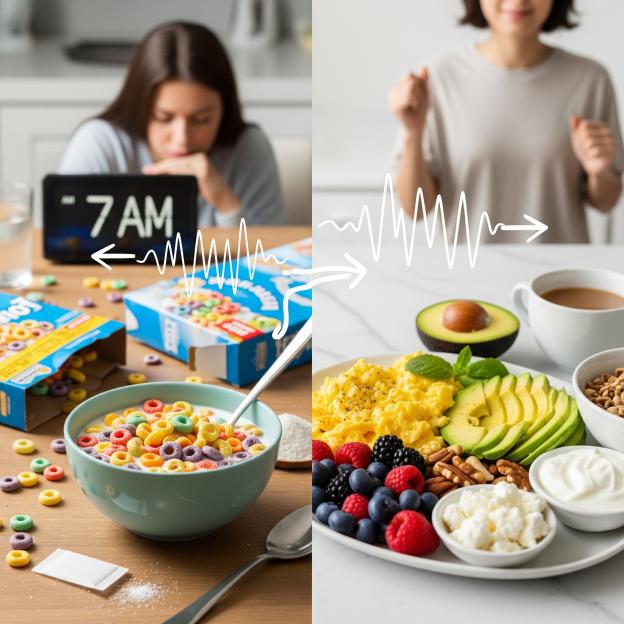The Morning Ritual That’s Quietly Sabotaging Your Day
It’s 7 AM, you’re rushing to get ready for work, and you reach for that familiar box of cereal. The colorful packaging promises energy, nutrition, and a great start to your day. But as you pour that bowl and add milk, you might be setting yourself up for an energy crash, hunger pangs, and a cascade of health issues that could affect your entire day - and your long-term wellbeing.
The truth about breakfast cereal isn’t what the billion-dollar marketing campaigns want you to believe. Behind those health claims and whole grain promises lies a breakfast choice that could be undermining your metabolism, energy levels, and overall health in ways you never imagined.
The Hidden Sugar Bomb in Your Bowl
When you think about sugary foods, candy bars and donuts probably come to mind. But would you believe that many breakfast cereals contain more sugar per serving than a chocolate chip cookie? The average American breakfast cereal contains between 9-15 grams of sugar per serving, with some popular brands packing up to 18 grams - that’s nearly 5 teaspoons of sugar before you even add milk.
The Sugar Disguise Game
Food manufacturers have become masters at hiding sugar content through clever naming. Your cereal box might list:
- High fructose corn syrup
- Dextrose
- Maltodextrin
- Brown rice syrup
- Cane juice
- Fruit juice concentrate
These are all forms of added sugar, often appearing multiple times on the same ingredient list. This means your “healthy” whole grain cereal might actually be a sugar delivery system disguised as nutrition.
Blood Sugar Roller Coaster
When you eat a high-sugar breakfast cereal, your blood glucose levels spike rapidly within 30-60 minutes. Your pancreas responds by releasing insulin to bring those levels down, often causing them to crash below your starting point. This blood sugar roller coaster explains why you feel energized initially, then experience that mid-morning crash that has you reaching for more food or caffeine.
Research published in the American Journal of Clinical Nutrition shows that high-glycemic breakfast foods like most cereals can cause blood sugar swings that persist for hours, affecting concentration, mood, and hunger levels throughout the morning.
The Fiber Fiction and Empty Nutrition Promise
Marketing messages about “whole grains” and “good source of fiber” plaster cereal boxes, but the reality is far less impressive. Most breakfast cereals provide only 1-3 grams of fiber per serving - a fraction of what you need for digestive health and blood sugar control.
Processing Destroys Nutritional Value
The manufacturing process that creates those crispy flakes, loops, and clusters involves high heat, pressure, and chemical processing that strips away much of the grain’s original nutritional value. What remains is often a nutritionally depleted product that food companies then “fortify” with synthetic vitamins and minerals.
This fortification process creates nutrients that your body doesn’t absorb as effectively as those found naturally in whole foods. It’s like taking apart a car and putting it back together with different parts - it might look similar, but it doesn’t function the same way.
The Protein Problem
Most cereals contain minimal protein - typically 2-4 grams per serving. Protein is crucial for morning satiety, blood sugar stability, and maintaining energy levels. Without adequate protein, your breakfast cereal leaves you hungry and craving more food within a few hours.
Compare this to eggs, which provide 6 grams of complete protein per egg, or Greek yogurt with 15-20 grams per serving. The protein difference alone explains why cereal-based breakfasts often lead to mid-morning hunger and snacking.
The Artificial Ingredient Cocktail
Modern breakfast cereals are chemical laboratories disguised as food. A typical cereal contains dozens of artificial ingredients, preservatives, and additives that serve the manufacturer’s needs for shelf life and profitability rather than your nutritional needs.
Common Cereal Additives and Their Effects
BHT (Butylated Hydroxytoluene): A preservative linked to liver and kidney problems in animal studies. The European Union has restrictions on BHT use, but it remains common in American cereals.
Yellow Dye #6 and Red Dye #40: Artificial colors that have been linked to hyperactivity in children and may cause allergic reactions in sensitive individuals.
Trisodium Phosphate: Used to maintain texture, this industrial cleaning agent appears in many cereals. While generally recognized as safe in small amounts, it’s questionable whether we need cleaning chemicals in our breakfast.
The Preservative Problem
Breakfast cereals are designed to sit on shelves for months or even years without spoiling. This extended shelf life requires preservatives that prevent natural decomposition but may interfere with your body’s natural processes.
Fresh, whole foods spoil because they’re alive with nutrients and enzymes. Foods that don’t spoil often lack the vital nutrients your body needs to thrive.
How Cereal Disrupts Your Metabolism
Starting your day with a high-sugar, low-protein, heavily processed food sets your metabolism on a destructive path that can affect your energy, weight, and health for hours.
Insulin Resistance Development
Regularly consuming high-glycemic breakfast foods like cereal can contribute to insulin resistance over time. When your cells become less responsive to insulin, your body produces more of this hormone to achieve the same blood sugar control effect.
This excess insulin promotes fat storage, particularly around your midsection, and makes it increasingly difficult to lose weight. The morning blood sugar spike from cereal can be particularly damaging because cortisol levels are naturally highest in the morning, amplifying insulin’s effects.
Leptin Disruption
Leptin is your body’s satiety hormone - it tells your brain when you’ve eaten enough. High-sugar foods like cereal can disrupt leptin signaling, making it harder for your body to recognize fullness and leading to overeating throughout the day.
Studies show that people who eat high-sugar breakfasts tend to consume more calories throughout the day compared to those who start with protein and healthy fats.
The Inflammatory Response
Processed cereals trigger inflammatory responses in your body. The combination of refined grains, added sugars, and artificial ingredients creates oxidative stress and inflammation that can affect everything from joint health to brain function.
Chronic inflammation is linked to numerous health problems, including heart disease, diabetes, arthritis, and accelerated aging. Starting every day with an inflammatory food perpetuates this cycle.
The Marketing Deception: Health Claims vs. Reality
The breakfast cereal industry spends billions of dollars annually convincing consumers that their products are healthy breakfast choices. These marketing messages are carefully crafted to emphasize minor positive aspects while downplaying significant nutritional shortcomings.
“Part of a Complete Breakfast” Myth
You’ve seen the commercials showing cereal alongside fruit, toast, and orange juice, claiming this combination creates a “complete breakfast.” This marketing tactic implies that cereal is an essential component, when in reality, the other foods (particularly the fruit) provide most of the actual nutrition.
Remove the cereal from this “complete breakfast,” and you’d actually have a more nutritious meal with better blood sugar stability.
Whole Grain Confusion
“Made with whole grains” doesn’t mean the product is predominantly whole grain. A cereal can legally make this claim if it contains any amount of whole grain, even if refined flour is the primary ingredient.
True whole grain products list whole grain as the first ingredient and don’t contain added sugars or artificial ingredients. Most breakfast cereals fail both criteria.
Heart-Healthy Claims
Many cereals display heart-healthy symbols and claims based on minimal criteria like containing 3 grams of fiber or being low in saturated fat. These claims ignore the high sugar content, artificial ingredients, and processing that may actually harm cardiovascular health.
Real-World Impact: What Happens When You Eat Cereal Daily
To understand the true impact of starting your day with cereal, let’s follow what happens in your body during the hours after that seemingly innocent bowl.
Hour 1: The Sugar Rush
Within 30-60 minutes of eating cereal, your blood glucose spikes to levels similar to eating candy. Your pancreas releases insulin to manage this surge, and you might feel temporarily energized.
Hour 2: The Crash Begins
As insulin does its job, your blood sugar drops rapidly, often falling below your starting level. You begin feeling tired, irritable, and hungry again. Your brain, which relies on steady glucose, starts sending hunger signals.
Hour 3: The Craving Cycle
Low blood sugar triggers cravings for quick energy - usually more sugar or caffeine. You might reach for a snack, coffee, or start thinking about lunch even though breakfast was recent.
Hour 4-6: Metabolic Confusion
Your body struggles to stabilize blood sugar and energy levels. Cortisol and other stress hormones may remain elevated, affecting mood, concentration, and decision-making throughout the morning.
Long-term Effects
Repeating this cycle daily can contribute to:
- Weight gain and difficulty losing weight
- Increased risk of type 2 diabetes
- Energy fluctuations and fatigue
- Mood swings and irritability
- Increased hunger and food cravings
- Poor concentration and brain fog
The Hidden Costs: Beyond Personal Health
Choosing cereal for breakfast impacts more than just your personal health. The environmental and economic costs of this choice ripple through society in ways most people never consider.
Environmental Impact
Breakfast cereal production requires extensive processing, packaging, and transportation. The heavily processed nature of these products creates a significant carbon footprint compared to simple, whole food alternatives.
The packaging alone - those colorful boxes, plastic bags, and toy inserts - contributes to landfill waste. Most cereal packaging isn’t recyclable due to its mixed materials and chemical coatings.
Economic Considerations
Pound for pound, breakfast cereal is one of the most expensive foods in the grocery store. You’re paying premium prices for cheap ingredients (corn, wheat, sugar) that have been processed and packaged with extensive marketing costs built into the price.
A family spending $5-7 per box on cereal could purchase eggs, meat, vegetables, and other whole foods that provide superior nutrition at similar or lower costs.
Better Breakfast Alternatives: Fueling Your Body Right
Understanding why cereal makes a poor breakfast choice naturally leads to the question: what should you eat instead? The best breakfast alternatives share common characteristics - they’re rich in protein, contain healthy fats, include fiber from whole food sources, and minimize added sugars.
Protein-Powered Options
Eggs in Various Forms: Scrambled, hard-boiled, or in an omelet with vegetables. Eggs provide complete protein, healthy fats, and nutrients like choline for brain health.
Greek Yogurt Parfait: Plain, full-fat Greek yogurt with berries and nuts offers probiotics, protein, and natural sweetness without added sugars.
Protein Smoothies: Blend protein powder with leafy greens, berries, and healthy fats like avocado or almond butter for a nutrient-dense meal.
Healthy Fat Combinations
Avocado Toast: Whole grain bread topped with mashed avocado, a sprinkle of salt, and optional additions like tomatoes or eggs.
Nut Butter and Fruit: Apple slices with almond butter or berries with coconut butter provide satisfying fats and natural sugars.
Chia Seed Pudding: Chia seeds soaked in coconut milk with vanilla and cinnamon create a pudding-like texture rich in omega-3 fatty acids.
Fiber-Rich Whole Foods
Oatmeal Done Right: Steel-cut oats cooked with cinnamon and topped with nuts and berries provide sustained energy without blood sugar spikes.
Vegetable Scrambles: Eggs cooked with spinach, peppers, mushrooms, and other vegetables pack nutrition and fiber.
Breakfast Salads: Yes, salads for breakfast! Mixed greens with leftover protein, nuts, and a light vinaigrette offer excellent nutrition.
Making the Transition: Practical Steps to Break the Cereal Habit
Changing long-established breakfast habits can feel challenging, especially when cereal seems convenient and familiar. However, with the right strategies, you can successfully transition to healthier options that actually save time and improve how you feel.
Week 1: Preparation and Mindset
Start by cleaning out your pantry. Remove tempting cereal boxes to eliminate the easy option. Stock up on whole food alternatives like eggs, nuts, seeds, and fresh produce.
Prepare breakfast components in advance. Hard-boil a dozen eggs on Sunday, pre-cut vegetables for omelets, or prepare overnight chia puddings for grab-and-go options.
Week 2: Simple Swaps
Replace cereal with equally convenient options. If you’re used to eating cereal while reading the news, try Greek yogurt with berries or pre-made egg muffins.
Focus on protein at every breakfast. Aim for 20-25 grams of protein to maintain stable blood sugar and satiety until lunch.
Week 3: Building New Habits
Experiment with different combinations to find your favorites. Try various egg preparations, different nut butters, or creative smoothie combinations.
Pay attention to how you feel throughout the morning. Notice improved energy levels, reduced cravings, and better concentration compared to cereal-eating days.
Week 4: Long-term Success
Plan for challenging situations. Keep hard-boiled eggs or nuts available for busy mornings. Identify healthy breakfast options at restaurants or coffee shops for when you’re traveling.
The Science Behind Better Breakfast Choices
Research consistently shows that starting your day with protein and healthy fats rather than refined carbohydrates improves multiple health markers and daily performance indicators.
Blood Sugar Stability Studies
A study published in the Journal of Nutritional Science compared breakfast meals with different macronutrient compositions. Participants who ate protein-rich breakfasts showed:
- 30% better blood sugar control throughout the morning
- Reduced food cravings for 4-6 hours after eating
- Improved cognitive performance on attention and memory tests
- Lower cortisol levels indicating reduced stress response
Weight Management Research
Long-term studies tracking breakfast habits and weight outcomes show that people who eat protein-rich breakfasts are more successful at maintaining healthy weights. The increased satiety from protein reduces overall daily calorie intake without conscious restriction.
Metabolic Health Improvements
Research from the American Diabetes Association shows that reducing refined carbohydrate intake at breakfast can improve insulin sensitivity within just two weeks. Participants showed measurable improvements in glucose tolerance and reduced insulin requirements.
Special Considerations: Age Groups and Health Conditions
Different life stages and health conditions may require specific approaches to moving away from cereal-based breakfasts.
Children and Adolescents
Kids accustomed to sweet cereals may resist healthier options initially. Gradually reduce sweetness while increasing protein and healthy fats. Try:
- Smoothies with hidden vegetables and protein powder
- Egg muffins with colorful vegetables
- Homemade granola with nuts and minimal sweetener
- Greek yogurt parfaits with berries
Focus on involving children in breakfast preparation to increase acceptance of new foods.
Adults with Diabetes
People managing diabetes can see dramatic improvements in blood sugar control by eliminating high-glycemic breakfast cereals. Work with healthcare providers to adjust medications as dietary changes improve glucose control.
Monitor blood sugar responses to different breakfast options to identify the most effective choices for individual metabolism.
Seniors
Older adults may need additional protein to maintain muscle mass and bone health. Breakfast becomes even more important for providing essential nutrients that support healthy aging.
Easy-to-digest options like soft scrambled eggs, smoothies, or Greek yogurt can provide excellent nutrition without digestive stress.
Addressing Common Concerns and Objections
When people learn about cereal’s health impacts, they often raise practical concerns about making changes. Let’s address the most common objections with realistic solutions.
“I Don’t Have Time in the Morning”
Healthy breakfasts can be faster than cereal when properly planned:
- Hard-boiled eggs prepared in advance take 30 seconds to grab
- Greek yogurt with nuts requires no preparation
- Smoothies can be pre-portioned and blended in under 2 minutes
- Overnight oats or chia puddings are ready when you wake up
“Healthy Options Are Too Expensive”
While some healthy foods cost more per item, they provide better nutrition per dollar and keep you satisfied longer:
- Dozen eggs cost less than a box of cereal and provide more meals
- Buying nuts and seeds in bulk reduces costs significantly
- Seasonal fruits and vegetables offer affordable nutrition
- Preparing food at home always costs less than processed alternatives
“My Kids Won’t Eat Anything Else”
Children’s taste preferences are more flexible than parents often believe:
- Gradual changes work better than sudden switches
- Involve kids in meal planning and preparation
- Focus on natural sweetness from fruits rather than added sugars
- Make healthy options fun and visually appealing
- Be patient - it can take 10-15 exposures for kids to accept new foods
“I Need the Convenience”
Convenience doesn’t require compromise on nutrition:
- Batch prepare breakfast components on weekends
- Use slow cookers or pressure cookers for hands-off cooking
- Keep emergency healthy options available (nuts, hard-boiled eggs)
- Identify healthy grab-and-go options at local stores
The Bigger Picture: Transforming Your Relationship with Food
Moving away from breakfast cereal often represents a larger shift toward valuing nutrition over marketing convenience over long-term health. This change can catalyze improvements in other areas of your diet and lifestyle.
Developing Food Awareness
Learning to read ingredient lists and understand nutrition labels becomes easier with practice. The skills you develop evaluating breakfast options apply to all food choices throughout the day.
Understanding Hunger and Satiety
Eating nutrient-dense breakfasts helps you recognize true hunger versus cravings caused by blood sugar fluctuations. This awareness improves eating patterns throughout the day.
Building Cooking Confidence
Simple breakfast preparation builds cooking skills and confidence that extend to other meals. Starting with easy techniques like scrambling eggs or blending smoothies can lead to more adventurous cooking.
Long-term Health Benefits: What to Expect
People who successfully transition away from breakfast cereal often report improvements that extend far beyond the morning hours.
Short-term Benefits (1-2 weeks)
- More stable energy levels throughout the morning
- Reduced mid-morning hunger and cravings
- Improved concentration and mental clarity
- Better mood stability
- More satisfying breakfast experience
Medium-term Benefits (1-3 months)
- Easier weight management
- Improved blood sugar control
- Better digestive health
- Increased nutrition intake
- Reduced dependence on caffeine for energy
Long-term Benefits (6+ months)
- Lower risk of metabolic syndrome
- Improved cardiovascular health markers
- Better bone and muscle health from increased protein
- Enhanced insulin sensitivity
- Reduced inflammation markers
Creating Your Personal Breakfast Revolution
The journey away from breakfast cereal isn’t just about changing one meal - it’s about reclaiming control over your health and energy levels. Every morning presents an opportunity to fuel your body with nutrients that support optimal function rather than foods that work against your wellbeing.
Setting Realistic Expectations
Change doesn’t happen overnight, and perfection isn’t the goal. Focus on progress rather than perfection, and celebrate small victories along the way.
Some days might still include convenient options that aren’t ideal - that’s normal and acceptable. The goal is overall improvement, not dietary perfection.
Building Support Systems
Share your goals with family and friends who can support your efforts. Consider finding online communities or social media groups focused on healthy eating for motivation and recipe ideas.
If you have family members resistant to change, focus on your own breakfast choices while gradually introducing healthier options for others.
Tracking Progress
Keep a simple food and energy journal for the first few weeks. Note what you eat for breakfast and how you feel throughout the morning. This record will help you identify the most effective options for your individual needs.
Conclusion: Your Morning Matters More Than You Think
The breakfast choice you make each morning ripples through your entire day, affecting your energy, mood, concentration, and long-term health. While breakfast cereal has been marketed as a convenient, healthy option, the reality is that it often sabotages your body’s natural rhythms and sets you up for energy crashes, cravings, and metabolic dysfunction.
Breaking free from the cereal habit isn’t about perfection or complicated meal planning - it’s about choosing real foods that work with your body instead of against it. Whether you opt for eggs, Greek yogurt, smoothies, or any number of whole food alternatives, you’re investing in sustained energy, better health, and improved quality of life.
Your morning routine shapes your entire day. Make it count with choices that truly nourish your body and support your goals. The difference you’ll feel - in energy, mood, and overall wellbeing - will remind you every morning why this change was worth making.
The next time you’re tempted by those colorful cereal boxes and their promises of quick nutrition, remember that the best breakfast isn’t the most convenient one on the shelf - it’s the one that gives your body what it actually needs to thrive.







